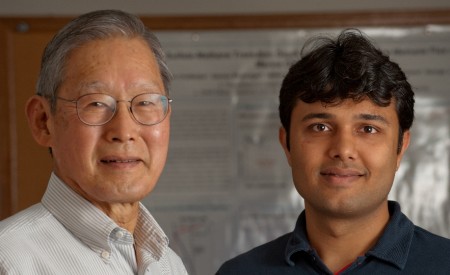Sep
16
Better Methane Gas Hydrate Numbers
September 16, 2011 | Leave a Comment
The thinking is in many quarters that methane gas hydrates, often referred to the ice that burns, or more simply methane hydrates exists in quantities far over the combined oil natural gas and coal reserves. Today’s estimate numbers reach 20 trillion tons. It’s a huge number, and controversial. So how could one more reliably size the reserve up without drilling hundreds of thousands of test borings and spending huge sums of money doing that?
In 2007 Chemical engineers George Hirasaki and former graduate student Gaurav Bhatnagar at Rice University theorized that methane could be detected via transition zones 10 to 30 meters below the seafloor near continental shores. At that level sulfate, a primary component of seawater and methane to react and consume each other.
What happens is as sulfate migrates deeper into the sediment below the seafloor, it decreases in concentration, as evidenced by measurements of the water (pore water) trapped between sediment particles from core samples. The depth at which the sulfate in the water gets completely consumed upon contact with methane rising from below is the sulfate-methane transition (SMT) zone.
In 2007 Bhatnagar argued in a paper the depth of this transition zone serves as a proxy for quantifying the amount of gas hydrates that lie beneath; the shallower the SMT, the more likely methane will be found in the form of hydrates in abundance at greater depth.
Sounds good. But . . .
The controversy that followed the publication of the original paper focused on sulfate consumption processes in shallow sediment and whether methane or organic carbon was responsible. Skeptics felt the basis of Bhatnagar’s model, which assumes methane is a dominant consumer of pore-water sulfate, was not typical at most sites. That sort of blew the idea as being truly representative.

Rice University chemical engineer George Hirasaki, left, and graduate student Sayantan Chatterjee. Click image for the largest view.
Sayantan Chatterjee, a fifth-year graduate student in Hirasaki’s lab, set out to prove the theory by bringing more chemical hitchhikers into the test matrix. He added bicarbonate, calcium and carbon isotope profiles of bicarbonate and methane to the model. Chatterjee says, “Those four additional components gave us a far more complete story.” The paper was published this week by the Journal of Geophysical Research — Solid Earth
Hirasaki, who is Rice’s A.J. Hartsook Professor of Chemical and Biomolecular Engineering explains that including a host of additional reactions in their calculations on core samples, “can give a much stronger argument to say that methane flux from below is responsible for the SMT. The big picture gives more evidence of what’s happening, and it weighs toward the methane/sulfate reaction and not the particulate organic carbon.”
The Rice team sees two audiences for the research and the results that could be generated. The first is the natural gas industry and its customers eyeing an energy resource. The second is the global warming crowd who see methane as the mother of all greenhouse gases. That makes two diametrically opposed views eager to find out what’s down there.
For now Chatterjee had the chance to discuss his results with his peers in July at the seventh International Conference on Gas Hydrates in Edinburgh, Scotland, where he presented a related paper that focused on the accumulation of hydrates in heterogeneous submarine sediment. The conference paper was awarded a first prize at the prestigious Society of Petroleum Engineers’ Young Professionals meeting and placed second at the Gulf Coast Regional student paper competition.
The Rice group has embarked on an important job for the future. Much to the relief of long range planners for natural gas usage it looks like the Rice technique is going to have a noteworthy effect on helping locate the easiest and least expensive methane hydrate deposits. One suspects that the basic idea isn’t going to help out the global warming crowd all that much – not that they won’t try to twist it to their advantage. The global warming worry depends on releasing methane from depths that when warmed will give up methane – not something the Rice team was targeting – they’re looking much deeper and for truly large deposits.
The Rice group’s work isn’t going to be a revolution, rather is a big step of evolution to getting sources spotted that can justify the research needed to learn how to extract the methane at minimal cost and the least amount of environmental disturbance. Just narrowing down the possible sites to the most desirable is going to help.
Once the best prospects can be quantified the really developmental research can get under way. Its one thing to experiment – and quite another when there are known billions of dollars of profit for serving a market.

